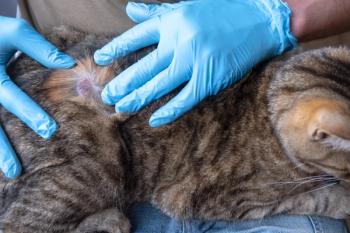
2010: Recruitment odyssey
National Report - Good employees are hard to come by, and it won't get easier any time soon.
NATIONAL REPORT — Good employees are hard to come by, and it won't get easier any time soon.
National employment projections indicate that with baby boomers planning to retire, businesses will struggle to find enough help as early as 2010, when the country's largest generation will be age 46 to 64.
Many practices already feel the employment pain. Employee retention is the No. 2 most-pressing issue facing veterinary medicine, veterinarians report in the DVM Newsmagazine 2006 State of the Veterinary Profession Survey. About 14 percent said employee retention was the most pressing issue facing veterinary medicine — almost half indicated rising costs was the profession's most pressing issue — and about 13 percent said staff turnover is their greatest professional concern, behind work/life balance and money.
"We're in a stable phase right now, but staffing is probably the biggest practice concern for all practices, and it has been that way for years," says Dr. Timothy Howell, owner of the Cat Care Clinic in Indianapolis.
It could get worse before it gets better as many economists predict that an impending shortage could prompt wage wars as large and small businesses alike compete for fewer prime-aged workers.
"Moving into the next three to five years, you are going to see some labor shortages, much like we saw in the late 1990s," says Chad Moutray, chief economist for the Office of Advocacy of the U.S. Small Business Administration. "You are going to see a massive increase in the number of workers that are going to be required to fulfill that turnover as the baby boomers leave the workplace, and that's going to create a large labor shortage, and you already see it today in some of the specialty fields."
Veterinarians are not alone. Although the Bureau of Labor Statistics (BLS) makes absolutely no mention of a labor shortage in its biennial labor report: "Labor Force Projections to 2014: Retiring Boomers," the report says labor-supply growth is shrinking, and the workforce is increasingly gray. "The result is a decrease in the overall labor force participation rate and a slower rate of growth of the labor force," reports BLS Economist Mitra Toosi.
BLS projects that between 2004 and 2014, 39 million workers will enter the labor force and more than 24 million will leave. These figures compare with nearly 33 million entrants and more than 19 million who exited in 1994 to 2004.
"Small firms are at a large disadvantage there because we don't have the benefits of some of the larger firms, so they really don't have the capacity to compete in some of those areas, and so it's going to be a real challenge to fill those jobs," Moutray says.
Table 1 Can you find registered veterinary technicians in your area?
Private practices likely will feel a sting, especially in the already-tight market for credentialed technicians.
Fewer veterinarians report being able to find qualified technicians in their area compared to 2003 (Table 1).
And finding them is just the beginning. Retaining staff remains a major operational concern, DVMs report. About two-thirds of respondents filled at least two existing positions in 2005, and on average, practices needed to fill 3.1 positions; just 16.5 percent had no turnover (Table 2).
Table 2 The average number of existing positions filled in 2005 was 3.1
The average length of a veterinary technician's tenure is 5.2 years, and about 22 percent stay at a practice for more than eight years (Table 3).
That's a little better than the national average of about four years, says Gregory P. Smith, founder of Chart Your Course International, a management-consulting firm, and author of "Here Today Here Tomorrow: How to Transform Your Workforce from High Turnover to High Retention". But it's more difficult to replace highly skilled workers than, say, hospitality workers.
Table 3 Average length of employment for veterinary technicians is 5.2 years
"It's becoming more and more true in specialized businesses; employees are more difficult to keep," Smith says. "Part of the driving force in healthcare and veterinary medicine is that you are getting a younger workforce, and the work ethic is different. They are not going to break their back for the clinic, so you have to depend on doing other things to attract people and engage them."
Howell, who is part of a national study group that examines staffing issues, says the key to recruitment and retention is above-average compensation, especially in tight labor markets like Indianapolis, where Eli Lilly & Co. offers a generous salary and benefits package to recruit and retain veterinary professionals.
"We pay more so there is less turnover. With the costs associated with lost efficiency and training time, you really take it to heart and pay more to keep that from happening," Howell says. "But when you get right down to it, it's probably more about the way they are treated and appreciated."
In a National Association of Veterinary Technicians in America (NAVTA) survey in 2003, about 15 percent say they will probably or definitely change their career in the future. More than 83 percent agreed with the statement: "Veterinary technicians are so underpaid that the feasibility of staying in the profession is declining."
But that tide might be changing, says Brakke Consulting's Karen Felsted CPA, MS, DVM, CVPM.
"Veterinarians are becoming more educated about the fact that if you are going to get quality people, then you are going to have to pay for them," says Felsted, who is also editorial adviser to Veterinary Economics. "If you just want more bodies, then sure, you can pay them minimum wage. But if you want quality people who can provide high-quality services, then it's going to cost some money."
But money isn't the only issue. Although two-thirds of respondents in the NAVTA survey indicated that salary was their No. 1 issue, appreciation, opportunities for advancement and competition from non-credentialed aids that learned on the job ranked high as well.
More than half disagreed or strongly disagreed with the statement: "As a technician, I am currently happy with the level of recognition and support given to veterinary technicians by professional veterinary organizations."
"They have to feel like there is a sense of worth in what they are doing," Smith says. "Nationwide, the average tenure is four years, and it goes down lower depending on the age of the individual. So this sense of purpose is pretty important."
Creating that sense of personal importance starts with the boss, Smith says.
"In healthcare, we've found that the personal skills of the chief professional is critical in creating a high-retention work environment," he says. "That's why it's important that they have good people skills. Most of these places in larger organizations have some sort of training program for people to learn how to manage, motivate, counsel and help a person develop in an organization; in a small clinic, that is a little more difficult."
It might be difficult, but it's imperative to assess employee expectations, especially in the first 30 days, Smith says.
"Not only do you want to hire the right personalities, you want to make sure they clearly understand what their job entails before they start. A lot of turnover occurs because a gung-ho technician (or associate) has in their mind that they will be able to practice at a certain level, and then they find out that it's not what they expected, and that creates low job satisfaction and turnover," he says. "So a shadow day can help clarify those expectations."
SMITH'S TAKEAWAY
- Identify expectations, goals and dreams of each employee within the first 30 days so all parties know the expectations; then continually assess how those goals change as the individual grows.
- Pay competitively.
- Create an open environment where people can really contribute, either through ideas and suggestions or just by sitting down and talking about issues.
Newsletter
From exam room tips to practice management insights, get trusted veterinary news delivered straight to your inbox—subscribe to dvm360.




